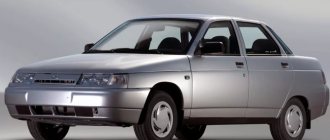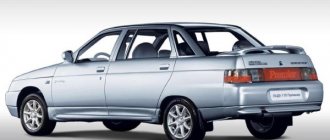VAZ 21099 is probably the most popular sedan in our country. Production of the car began in 1990 and successfully continued until 2004, and in Ukraine even until 2011. The model differed from other cars in its family in body kits, dashboard, and interior trim. Later, all this began to be used in new Lada models.
Consumption of VAZ 21099 with an injector
Injectors began to be installed on the VAZ 21099 in 2000. Direct fuel injection made it possible to increase the power of power units, while reducing their fuel consumption. The most popular injection modification of the car comes with a 1.5 engine. The designers increased the power to 78 hp, acceleration to hundreds is 13.5 seconds with a maximum speed of 155 kilometers per hour with fuel consumption:
- in traffic 8.8 l;
- on average 7.4 l;
- on a country road 5.4 liters.
The most powerful version with a volume of 1.6 produces 81 hp, reaches a speed of 165 km/h, and the first hundred in 13 seconds. At the same time, the car’s appetite remains quite modest:
- on busy streets 9.1 l;
- mixed mode 7.7 l;
- track 5.7 l.
Real consumption according to reviews
- Svyatoslav, Chelyabinsk. I took the “99” model in 2012 as a workhorse. I chose the option with the 1.5 engine. A very reliable option with an injector, I’m very happy with the car, I go both for work and for fishing, the ground clearance allows me to go outdoors without problems. The consumption of AI 95 in a circle is about 8 liters.
- Sergey, Barnaul. VAZ 21099 2003 with an injector. The car was in excellent condition, nothing had to be done. Over time, I treated the body and repaired the chassis several times - but this is a necessary evil on our roads. The 1.5 engine is very good - it pulls consistently, I only change consumables, I didn’t have to clean the injector. Consumption in the city is no more than 9 liters, and on the highway the car takes 6-7 liters.
- Dmitry, Ulyanovsk. In 2004, I took the most sophisticated version of the VAZ 21099 Lux with a 1.6 engine. The car is powerful, reliable, roomy, and passable. Repairs cost pennies, and they have to be done infrequently; I didn’t do anything to the engine, gearbox, or injector. The average consumption is 7-9 liters, which corresponds to the passport data.
What causes high fuel consumption on the VAZ-2109
What is the real consumption of Niva 21213 with an injector?
The reasons are mainly as follows:
The carburetor air damper is not open enough. When the motor is running, this mechanism is carefully closed and in a vertical position. In this case, the “choke” handle should be pulled out towards you. If the damper is slightly open, it causes a malfunction. In this case, gasoline is consumed in large quantities, and the volume of air that enters the fuel mixture decreases. To solve this problem, some owners close the carburetor air damper, thereby enriching the fuel mixture. However, this threatens to increase fuel consumption several times. It is better to adjust the air damper drive, and then the problem will be partially solved.
The fuel nozzle holder is not installed tightly enough. With this problem, the fuel mixture enters the cold running system, bypassing the fuel nozzle. This leads to fuel entering the cylinders not only at idle, but also in any mode. To fix this problem, you need to check the tightness of the holder. Over-tightening is not allowed because this may cause deformation.
You need to tighten it carefully, but at the same time so that the holder can twist itself out from vibration. On a carburetor with a solenoid valve, you need to check how well it functions
On the motor you need to remove the plug and put on the wire. If the valve is working properly, then shut off the fuel supply by turning the housing clockwise. Lack of tightness of the needle valve of the float chamber. With this problem, excess gasoline enters the float chamber and then into the engine cylinders. This often occurs if the needle valve is faulty. In this case, you need to check the tightness of the device. This procedure is described in any instructions or manual for using the car, so it will not be difficult to perform. It is advisable to replace the needle valve if this problem occurs. There is no point in repairing, since you will have to pay more for repairs than for a new mechanism. There are fuel jets for the main metering system. In such a situation, the fuel becomes over-enriched. Here you need to check the markings of the jets. This is a rather complicated procedure, so it is better to ask specialists for help. The jets are too clogged. This is a fairly common reason, which is absolutely easy to solve. You need to clean the jets by removing the carburetor cover. This can also be done without removal, but in this case you will have to spend a lot of time and effort. Malfunction in the forced idle economizer. The solenoid valve or other system mechanism may be faulty here. This usually occurs due to rough idling of the engine. You need to check the system and troubleshoot problems. The engine filter is clogged. The fuel mixture is greatly enriched in fuel as air enters it through the filter element. It is necessary to clean the clogged elements, and then the problem will be eliminated. This must be done carefully so as not to damage anything.
It happens that such a problem is provoked by the following phenomena:
- faulty motor or injector;
- problem with engine thermal conditions;
- the ignition timing is incorrectly set;
- lack of tightness of fuel system elements. In this case, gasoline simply flows out of the gas tank;
- The car wheels do not release the brakes well. This is the most common reason for fuel consumption. This happens due to the fact that the rolling resistance of the machine increases;
- Wheel bearings that are too tight. In this case, the resistance to movement of the vehicle increases, resulting in fuel consumption;
- low tire pressure. This can be checked using a pressure gauge;
- wheel mounting angles are broken;
- problems with spark plugs;
- problems with the centrifugal and vacuum regulators.
As we can see, there are quite a few reasons for the high fuel consumption of the VAZ-2109. In order to find out what exactly caused the loss of gasoline, you need to understand your car very well and thoroughly know the design of the vehicle. If you find it difficult to determine and eliminate the causes of a malfunction, then you can always contact a technical service, where this problem will be quickly resolved. From time to time, the car must be shown to specialists so that it functions properly for a long time and does not require frequent repairs.
Consumption of VAZ 21099 with an injector
VAZ 2131 fuel consumption: gasoline per 100 km
Injectors began to be installed on the VAZ 21099 in 2000. Direct fuel injection made it possible to increase the power of power units, while reducing their fuel consumption. The most popular injection modification of the car comes with a 1.5 engine. The designers increased the power to 78 hp, acceleration to hundreds is 13.5 seconds with a maximum speed of 155 kilometers per hour with fuel consumption:
- in traffic 8.8 l;
- on average 7.4 l;
- on a country road 5.4 liters.
The most powerful version with a volume of 1.6 produces 81 hp, reaches a speed of 165 km/h, and the first hundred in 13 seconds. At the same time, the car’s appetite remains quite modest:
- on busy streets 9.1 l;
- mixed mode 7.7 l;
- track 5.7 l.
Real consumption according to reviews
- Svyatoslav, Chelyabinsk. I took the “99” model in 2012 as a workhorse. I chose the option with the 1.5 engine. A very reliable option with an injector, I’m very happy with the car, I go both for work and for fishing, the ground clearance allows me to go outdoors without problems. The consumption of AI 95 in a circle is about 8 liters.
- Sergey, Barnaul. VAZ 21099 2003 with an injector. The car was in excellent condition, nothing had to be done. Over time, I treated the body and repaired the chassis several times - but this is a necessary evil on our roads. The 1.5 engine is very good - it pulls consistently, I only change consumables, I didn’t have to clean the injector. Consumption in the city is no more than 9 liters, and on the highway the car takes 6-7 liters.
- Dmitry, Ulyanovsk. In 2004, I took the most sophisticated version of the VAZ 21099 Lux with a 1.6 engine. The car is powerful, reliable, roomy, and passable. Repairs cost pennies, and they have to be done infrequently; I didn’t do anything to the engine, gearbox, or injector. The average consumption is 7-9 liters, which corresponds to the passport data.
Gas consumption and savings
Consumption of liquefied petroleum gas by the LADA 21099 sedan in liters per 100 km.
The difference in the cost of refueling gasoline and gas. Propane consumption for sedans 21099, savings
| Engine | Gas type | Propane consumption modes | Fuel cost per 1000 km in city mode | ||||
| City | Route | Mixed | Petrol | Propane | Saving | ||
| 1.3MT | CIS | 10,0 | 6,3 | 8,5 | RUB 4,095 | 2,200 rub. | RUB 1,895 (47%) |
| 1.3MT | CIS | 13,8 | 7,7 | 11,0 | RUB 5,875 | RUB 3,036 | RUB 2,839 (49%) |
| 1.5 MT | CIS | 9,7 | 5,9 | 8,1 | RUB 4,136 | RUB 2,134 | RUB 2,002 (49%) |
| 1.5 MT | CIS | 10,0 | 6,3 | 8,5 | RUB 4,095 | 2,200 rub. | RUB 1,895 (47%) |
| 1.6MT | CIS | 10,0 | 6,3 | 8,5 | RUB 4,277 | 2,200 rub. | RUB 2,077 (49%) |
| LPG - liquefied petroleum gas (a mixture of propane and butane). Price per liter of propane in calculations: CIS - 22.00 rub. |
Methane and 21099. Methane equipment is not compatible with some engines. Check the technical feasibility of installing methane on your LADA 21099 sedan with the manager around the clock.
On average, methane consumption in the city is close to gasoline consumption. On the highway, consumption is 15-20% slower. Methane is cheaper than propane by one and a half rubles per liter.
Fuel consumption VAZ 2106 1.5l.
Fuel consumption of carburetor VAZ 2108, 2109, 21099
VAZ 2106 1.5. It was equipped with a gasoline carburetor engine and a five-speed manual transmission. The engine displacement is 1452 cc and power is 72 hp. Engine torque is 104 Nm at 3400 rpm. The car has a top speed of 150 km/h and accelerates from zero to hundreds in 17 seconds. Fuel consumption VAZ 2106 1.5l. in the city it is 9.8 liters, on the highway - 7.4 liters per hundred kilometers.
Real fuel consumption of VAZ 2106 1.5l.
- Vladislav. Samara. Six years ago I bought a second-hand “six” with a one and a half liter engine for work and I drive it to this day. What can I say, in my opinion, this is the best car for our roads. In addition, considering that the car rolled off the assembly line back in 1988, its condition can be said to be ideal. If your head “cooks” and your hands grow from the right place, then you can use the “six” for more than a dozen years. In terms of gasoline consumption, my average is ten liters in the city and up to 8.5 on the highway.
- Dmitriy. Kazan. My “swallow”, after a major overhaul in 2001, still doesn’t drive, but flies! I completely overhauled the engine and gearbox, changed all the consumables and slightly modernized the interior. Since then there have been no major problems. In terms of gasoline consumption, I get about ten liters when driving around the city and no more than nine on the highway.
- Egor. Samara. I inherited my “six” with a one and a half liter engine from my father in 1995. My father loved the car very much and looked after it carefully. The machine served me faithfully for ten years, after which I sold it. It seems to me that for our expensive VAZ 2106 it is exactly what we need. The machine is stable, durable, convenient, and most importantly, not expensive to maintain. In terms of gasoline consumption, I got no more than 10 liters in the city (in normal traffic) and up to nine liters on the highway.
- Ivan. Saint Petersburg. I bought the car off the production line in 1993. Of course, for greater comfort and safety I had to tighten some parts and blow out the bottom, but otherwise I was completely satisfied with the car. Playful, easy to control and stable. In addition, the suspension is not very stiff, and the interior is spacious and comfortable. I sold my “six” five years ago and today I already regret it. The car “eats” relatively little, and maintenance costs pennies. My gasoline consumption averaged up to 10 liters within the city and 7.5-8 liters on the highway, which I think is quite normal.
- Victor. Kostroma. I bought a used 1993 Six from a work colleague. What can I say, the car is a real classic of the domestic automobile industry. A spirited engine, a relatively soft suspension, a comfortable interior that warms up quickly in winter. In addition, if the hands grow from the right place, then maintenance costs mere pennies. Fuel consumption is also within normal limits: in the city up to ten liters, and on the highway (if you don’t drive) you can keep within 7.5-8 liters per hundred kilometers.
- Nikita. Moscow. I bought a “six” second hand after a major overhaul. At that time, it already had 7,000 kilometers on it. Today the mileage is 25,000 km, and I still have no complaints about the machine. It picks up speed quickly, has good stability and controllability, and most importantly, is inexpensive to maintain. In terms of gasoline consumption, everything also suits me: in the city with heavy traffic it turns out to be up to ten liters, and on the highway with normal driving you can keep within 8 liters.
- Victor. Stavropol. It seems to me that the “six” with a one and a half liter engine is an ideal car for those who are just acquiring driving skills and are trying to figure out how everything works in the engine, gearbox, etc. The car is easy to control, stable and playful. I’ve been riding mine for five years now and I don’t have any particular complaints, although I bought it used. Gasoline consumption is also within normal limits: in the city I get no more than ten liters, and on the highway, if I don’t drive, it’s 7.5-8 liters.
- Natalia. Belgorod. My husband bought a VAZ 2106 from 1988 from a friend. He said that this is an ideal option for acquiring driving skills. And today I understand that he spoke the truth. We made a capital investment immediately after the purchase, and to this day we have no complaints about the machine. Of course, this is not a foreign car with climate control and leather seats, but the car is quite enough for everyday movement around the city. In terms of gasoline, I get about ten liters in the city and 8-8.5 on the highway.
Owner reviews
“I have the most powerful ninety-nine with a rotary engine. I got it from my father, who bought himself a foreign car, and gave this car to me so that I could gain experience in driving and repairs. What can I say about the car. It looks quite tolerable, and my father took care of the car, so there is not even the slightest damage. The interior is poorly equipped, but all the necessary functions are available, so the ride is quite comfortable. There is a lot of space, enough for the whole family to travel, and even to throw things in. Well, the most important thing is the engine. It pulls very vigorously, and you can even reach decent speeds on the highway. Its only drawback is its high gasoline consumption, which reaches 15 liters in the city, and 8 on the highway,” Evgeniy from St. Petersburg left this review about the car.
“I passed my license and immediately started thinking about a car. I didn’t have a lot of money, and the requests for a future car did not suit every model. I couldn't find anything better than 21099, so I bought it. A good sedan that performs well on the highway, in the city, and on small off-road terrain. I often go on nature trips with friends, so the car is full of people and things. But this is not a hindrance for the ninety-ninth; it copes with its tasks perfectly. I try to actively monitor her condition so as not to kill her prematurely. Although this is very difficult to do. As for the consumption, it’s almost like the passport one, the difference is about a liter,” said Konstantin from Petrozavodsk about the car.
“I’ve always been for our cars, because I don’t need anything more. I love sedans, so I was choosing between several models, but settled on 21099. Its rectangular design evoked the most pleasant emotions in me. The interior is assembled with high quality, the materials are poor, but it doesn’t matter to me, the main thing is that it doesn’t fall apart. There is a lot of space, especially in the trunk. This is important to me, since I often carry out various transportations. Technical data at a high level. The car drives equally well both in the city and on the highway. I want to test it by going somewhere far into nature. Many people write that it shows excellent cross-country ability there too, but I want to make sure for myself. The only thing that annoys me is the high fuel consumption. I live in cold places, so in winter there are absolutely crazy numbers - up to 18 liters,” this review was written by Dmitry from Yakutsk.
“I bought this car immediately after receiving my license. I really regretted this decision after a year of use. Serious problems began with the chassis, in which I had already invested a lot of money. I drove for a couple of months and something broke in the engine. Again I took it to repairs and again paid a lot of money. Later, problems began with the body, although I always looked after the car, did not leave it dirty, and treated it with various preparations. I think I will sell it, since I no longer have the strength to buy it. Now she seems to be driving, but a new problem has appeared - consumption has increased. If earlier I spent no more than 10 liters, now my norm is 14. I was thinking about upgrading the firmware, since it is much cheaper than paying for extra liters of gasoline, especially since I still drive often,” these are the words about the car from Vladimir from Krasnodar.
“My grandfather gave me the car when he could no longer drive it himself. The condition was close to ideal, but this was not enough for me, and I decided to improve the car in various ways. This is not my main car, so I could afford such actions. I invested a lot of money into it over the course of a year. Probably, it was possible to buy a new good foreign car. But it wouldn't compare to what I have now. New sports body kits made in the best tuning studio in the country, a rebuilt interior, a reassembled dashboard, an extended body, thanks to which there is more space in the back row, doors that open upwards. Well, the most important thing is the engine. This is where most of the money is invested. But its power is now comparable to various BMWs and Mercedes. The most surprising thing is that its consumption has become less than it was in stock. Now I spend about 8 liters in the city,” these were the words the car received from Gennady from Moscow.
“At first I was not happy about this car, because they gave it to me without knowing whether I wanted it or not. But, since this is my first personal vehicle, I did not resist and slowly began to study the car. As it turned out, everything is not so bad. Yes, it’s not very attractive in appearance, and the interior is poorly decorated and not stuffed with various functions, but it’s not a shame to kill it, although I can’t imagine how this can be done. The body looks like it's made of armor. And various technical parts are assembled with high quality, nothing breaks. My motor is not the most powerful, but it is quite enough for a quiet ride around the city. I don’t plan to race, so I’m quite happy with everything. My consumption usually does not exceed 9 liters,” writes Valery from Kazan.
Source: driverstalk.ru
How to reduce fuel consumption on a VAZ 2109 carburetor
If you have high fuel (gasoline) consumption and you don’t know what the reason is, then for a VAZ 2109 car with a new carburetor or an old one
, this article may be useful, it is also relevant for other cars with similar characteristics.
It should be noted that the main reason for the increase in fuel consumption is a violation of the standard regulation of the power system. For this reason, many vehicle owners are interested in how to reduce fuel consumption on a VAZ 2109 carburetor that is configured incorrectly.
In order to find the cause of the malfunction, first of all, it is recommended to look under the air filter cover.
Common reasons for increased fuel consumption:
• Even a slight opening of the throttle can cause an increase in fuel consumption. A similar defect is quite common on Solex carburetors. • For Ozone carburetors, a common malfunction is poor operation of the shut-off valve in the float chamber. Thus, an engine idling will have wet diffusers due to fuel leakage
It is also recommended to pay attention to filters. A dirty filter can cause the mixture to become too rich.
• Another reason for high fuel consumption is a loose solenoid valve on DAAZ carburetors. Such a problem can lead to wear of the conical part of the jet, as well as the seat directly in the carburetor body. • Incorrectly set ignition timing. • Oxidation of the socket in the distributor cover and oxidation of the contacts of high-voltage wires. • Spark plugs working intermittently or not working at all. • Even poorly adjusted toe-in, defects in the brake system (seized pads) and insufficiently inflated tires can lead to increased fuel consumption.
The first way to reduce fuel consumption:
• A working engine should be warmed up to 80 degrees Celsius. • Looking at the position of the tachometer needle, set the speed approximately 15% higher than recommended in the car instructions. Adjustment is carried out using a quality screw. • Next, also use the quality screw, increase the speed even higher. At the same time, use the screw to reduce the speed to the starting position. • The adjustment procedure should be carried out until turning the screws (quality, quantity) does not produce an increase in speed. • Now, the quality screw should be tightened until the speed drops to the level specified in the instructions.
As a result, a level is reached at which the mixture will not become excessively lean, and the CO indicator will correspond to the norm. Next, you should check the operation of the engine. The mixture is too lean if the engine starts to stall when closing the throttle quickly or braking hard. In this situation, you need to slightly unscrew the quality screw.
The second way to reduce fuel consumption:
• For a serviceable engine, warm up the engine to 80 degrees Celsius. • Unscrew the quantity screw and set the crankshaft rotation speed to a level that should theoretically correspond to the parameters specified in the instructions supplied with the vehicle. • Next, also turn on the quality screw and increase the rotation speed a little more. • Slowly tighten the quality screw until the engine begins to “shake”, so to speak. In some cases, at the same time the speed screw should be added, especially if there is a strong drop in speed. • Then, unscrew the quality screw by approximately one-third of a turn so that the motor begins to operate stably. • Change the crankshaft rotation speed with the screw to the level specified in the instructions. At this stage, the adjustment can be considered complete.
What reasons influence high fuel consumption?
Already experienced drivers can tell exactly why their car, for one reason or another, has high gas mileage. We would like to give you an example of several problems that the owner of a VAZ 21099 car may encounter:
- poor or incomplete opening of the carburetor damper;
- lack of oil in the gearbox - leads to a reduction in transmission;
- the ignition timing is poorly set - early or late ignition reduces power;
- the vacuum accumulator sensor is faulty;
- when a large amount of fuel enters the carburetor.
How to reduce fuel consumption
Despite the efficiency of the VAZ 21099, there are often reviews of increased gasoline consumption. The most popular reason is the subjective factor. Driving too dynamically increases consumption by up to 50%. It is recommended to move off smoothly, change gears in time in the range of 2-3 thousand revolutions, and move on the highway at a speed of 90-100 mph. There are other problems that, by eliminating them, can reduce fuel consumption on the VAZ 21099:
- Engine wear. If the compression in the cylinders drops below 8.5 atmospheres, a major overhaul is necessary; after running in, the engine's appetite will decrease.
- Pressure in the slopes. The manufacturer recommends 2 atmospheres. A decrease in pressure is especially harmful; the car begins to “float” on the road, and consumption increases.
- Open windows at high speeds increase consumption by 1.5 liters, the turned on air conditioner takes 1 liter per hundred, so it is better to use it on long trips.
- There is no need to overload the car with tools and other items.
- Periodically adjust the carburetor and clean the injector; they become clogged, the quality of the mixture is impaired, which leads to overspending. If you don't pay attention to this, the car will simply break down.
Tips for saving fuel
You can actually save fuel
Many VAZ 21099 owners are interested in how to reduce fuel consumption. Here are some tips from the experts:
- Often, excessive consumption of gasoline occurs when compression in the engine cylinders is impaired or when it overheats. Measure the compression. If it is below 8.5, have the engine repaired. If the problem is overheating, drain the old antifreeze, flush the system, replace the coolant temperature and radiator fan sensors, and fill in with new antifreeze.
- Check tire pressure. The lower it is, the higher the consumption. Stick to the recommended values of 1.8 atmospheres for the front wheels and 2 atmospheres for the rear.
- If your car has air conditioning, consumption increases by 1 liter per 100 kilometers. There's nothing you can do - pay for comfort.
- Close the windows when driving on the highway; open windows at speeds above 70 km/h increase fuel consumption by 1-1.5 liters.
- Empty the trunk - it should contain a spare tire, tools, a tow rope, a warning triangle, a fire extinguisher and no more than 5 liters of technical fluids. The lighter the car, the less gasoline the car consumes.
- If you have a carburetor installed in your fuel supply system, check whether the brand of this device matches the type of engine installed on your car. When installing devices designed for 1.1 and 1.3 liter engines on more powerful engines, fuel consumption inevitably increases.
Follow these tips and remember: the less often you press the accelerator pedal to the floor, the fewer times you stop at the gas station.
Jets and valves - cleaning the carburetor
Devices such as jets control the necessary supply of fuel from the carburetor to the engine. In some cases, the repair consists of replacing them. The working jet must have three identical round holes; with prolonged operation they wear out and can be elongated. The hole in the middle of the nozzle head must be clean; various debris from low-quality fuel or from wear of the fuel hoses can get into it. Carefully inspect the rubber seal on the nozzle - if any breaks are found, replace it.
Carry out these steps for each jet. After completing these works, screw them back into the camera - this should be done by hand, and only in some cases with a screwdriver. A very common problem in carburetor operation is caused by poor contact in the solenoid valve. This happens due to oxidation of the terminal to which the wire is attached, so it needs to be cleaned and processed. In some cases, there is a breakdown in the switch, it may fail, so you will have to replace it with a new one.
One of the main devices in the carburetor is the fuel accelerator, which distributes fuel in the chambers. In practice, there are very few cases where this is the problem, but you shouldn’t rule it out. The accelerator needs to be washed or, if possible, replaced. It is best to clean your carburetor every six months. The cleaning product is available at any auto store. This procedure will significantly extend the life of your carburetor. If you are the owner of a VAZ 21099 with an injector, then on our website there is an article about this model.
Home →
Device → Fuel and exhaust systems → Carburetor →
Practical recommendations
Fuel consumption is affected by:
- technical condition of the machine;
- operating features.
In order to achieve more economical consumption, it is necessary to promptly clean and replace certain components of the mechanism.
In particular, an increase in the amount of gasoline or gas consumed is often a sign that the engine has almost exhausted its resource. Wear of the cylinder-piston increases the gaps between the cylinder walls and the rings. Because of this, exhaust gases and the fuel-air mixture enter the piston space. For the same reason, compression in the cylinders drops. The warm air mixture cannot burn completely. Therefore, part of the mixture remains unused and simply flies out through the exhaust pipe. Engine wear affects its functioning. Because of this, the car accelerates poorly. The driver has to press the pedal harder to accelerate the car. Taking all this into account, it is not difficult to conclude that in order to reduce gasoline or gas consumption, you must first diagnose the engine. You need to measure the compression, listen to whether the engine makes any unusual noises during operation. If worn components are found, they must be replaced.
Also, the consumption of gasoline or gas depends on the condition of the gas distribution mechanism. If carbon deposits that form on valve seats and edges are not promptly removed, this will lead to loss of compression due to a loose fit.
Cleaning the valves and, if necessary, repairing the cylinder head will significantly reduce gasoline/gas costs. It is important to promptly diagnose the gas distribution mechanism and promptly replace worn parts.
Fuel consumption also depends on the carburetor. If you install a contactless ignition system and a Solex carburetor, then this combination will reduce the amount of gasoline or gas consumed. It is very important to adjust the carburetor correctly. It will be possible to reduce consumption by installing jets with a reduced cross-section. However, this will lead to a decrease in the dynamics and power of the machine. After this adjustment you will have to forget about overtaking. It will be very difficult to accelerate such a car. Therefore, it is better to carry out adjustments without replacing the jets. It is necessary to adjust the carburetor in such a way as to achieve a “golden mean” between power and fuel consumption. If the carburetor is clogged and incorrectly adjusted, fuel dosing is disrupted. Therefore, regularly check the condition of the carburetor and wash it periodically.
What causes high fuel consumption on the VAZ-2109
The reasons are mainly as follows:
The carburetor air damper is not open enough. When the motor is running, this mechanism is carefully closed and in a vertical position. In this case, the “choke” handle should be pulled out towards you. If the damper is slightly open, it causes a malfunction. In this case, gasoline is consumed in large quantities, and the volume of air that enters the fuel mixture decreases. To solve this problem, some owners close the carburetor air damper, thereby enriching the fuel mixture. However, this threatens to increase fuel consumption several times. It is better to adjust the air damper drive, and then the problem will be partially solved.
The fuel nozzle holder is not installed tightly enough. With this problem, the fuel mixture enters the cold running system, bypassing the fuel nozzle. This leads to fuel entering the cylinders not only at idle, but also in any mode. To fix this problem, you need to check the tightness of the holder. Over-tightening is not allowed because this may cause deformation.
You need to tighten it carefully, but at the same time so that the holder can twist itself out from vibration. On a carburetor with a solenoid valve, you need to check how well it functions
On the motor you need to remove the plug and put on the wire. If the valve is working properly, then shut off the fuel supply by turning the housing clockwise. Lack of tightness of the needle valve of the float chamber. With this problem, excess gasoline enters the float chamber and then into the engine cylinders. This often occurs if the needle valve is faulty. In this case, you need to check the tightness of the device. This procedure is described in any instructions or manual for using the car, so it will not be difficult to perform. It is advisable to replace the needle valve if this problem occurs. There is no point in repairing, since you will have to pay more for repairs than for a new mechanism. There are fuel jets for the main metering system. In such a situation, the fuel becomes over-enriched. Here you need to check the markings of the jets. This is a rather complicated procedure, so it is better to ask specialists for help. The jets are too clogged. This is a fairly common reason, which is absolutely easy to solve. You need to clean the jets by removing the carburetor cover. This can also be done without removal, but in this case you will have to spend a lot of time and effort. Malfunction in the forced idle economizer. The solenoid valve or other system mechanism may be faulty here. This usually occurs due to rough idling of the engine. You need to check the system and troubleshoot problems. The engine filter is clogged. The fuel mixture is greatly enriched in fuel as air enters it through the filter element. It is necessary to clean the clogged elements, and then the problem will be eliminated. This must be done carefully so as not to damage anything.
It should be noted that too much fuel can be consumed not only due to problems with the carburetor.
- faulty motor or injector;
- problem with engine thermal conditions;
- the ignition timing is incorrectly set;
- lack of tightness of fuel system elements. In this case, gasoline simply flows out of the gas tank;
- The car wheels do not release the brakes well. This is the most common reason for fuel consumption. This happens due to the fact that the rolling resistance of the machine increases;
- Wheel bearings that are too tight. In this case, the resistance to movement of the vehicle increases, resulting in fuel consumption;
- low tire pressure. This can be checked using a pressure gauge;
- wheel mounting angles are broken;
- problems with spark plugs;
- problems with the centrifugal and vacuum regulators.
As we can see, there are quite a few reasons for the high fuel consumption of the VAZ-2109. In order to find out what exactly caused the loss of gasoline, you need to understand your car very well and thoroughly know the design of the vehicle. If you find it difficult to determine and eliminate the causes of a malfunction, then you can always contact a technical service, where this problem will be quickly resolved. From time to time, the car must be shown to specialists so that it functions properly for a long time and does not require frequent repairs.
Troubleshooting
Timely maintenance will extend the life of the car
If your car's fuel system has a carburetor, the algorithm is as follows:
- You should start by inspecting the fuel lines. It is quite possible that fuel is leaking through poorly tightened clamps or microcracks in the hoses and pipes.
- If the fuel lines are intact, then you should inspect the fuel tank and check the tightness of the filler cap. If the cap is not closed tightly in warm weather, gasoline may evaporate from the tank.
- Next, you should inspect the carburetor. It is possible that gasoline is evaporating or leaking through cracks in the lid or body of the device.
- The next step is to remove the VAZ 21099 air filter cover and inspect the filter element. If it is dirty, it needs to be replaced. The fact is that when the air filter is dirty, the amount of air in the combustible mixture decreases and, accordingly, the amount of fuel increases, which causes consumption to increase. The same thing happens when the air jets become dirty. You can recognize the over-enrichment of the combustible mixture by the black or dark gray color of the exhaust gases.
- Next, you need to inspect the fuel filter housing. If it is cracked, replace the fuel filter. Most fine fuel filters are made of transparent or translucent plastic. Thanks to this, you can see the dirt accumulated inside. Replacing the fuel filter should be done simultaneously with replacing the engine oil, oil and air filters. Otherwise, dirt will enter the carburetor and contaminate the jets and diffusers.
- Check the fuel pump for cracks and leaks.
- If a thorough inspection of the pump does not reveal any leaks, you will have to clean and adjust the carburetor.
Before setting up the carburetor, it is imperative to adjust the valves and set the correct ignition timing.
If you have a VAZ 21099 injector, you must perform the same steps, with the exception of inspecting the fuel pump. The difference is that instead of the carburetor, you will have to clean and adjust the injector. This procedure is complex, so it is better to carry it out at a car service center.
If you've followed the suggested steps and your car is still consuming too much fuel, take a closer look at how you measure your fuel consumption.
The secret of 99 - how is people's love justified?
The car, whose history goes back almost four decades, is still considered one of the most successful VAZ assemblies. Until 2004, all VAZ 21099 models had a carburetor engine type, and only after 2004 did manufacturers replace this device with an injector. So the carburetor 99, a symbol of the dashing 90s, is today found on the roads of post-Soviet countries no less often than modern cars.
The car has front-wheel drive, a 1.5 liter 4-cylinder engine. A VAZ car can accelerate to 160 km/h with its 70 hp. Some models have a 1.5i engine with 76 hp, although not many of these cars were produced. The carburetor of model 21099 is very economical, the average consumption of the VAZ 21099 reaches 7–7.5 l/100 km. Fuel consumption on the highway with high-quality fuel and average speed is 5.5 liters.
Adjusting the power system
If your car has a Solex carburetor, how to reduce fuel consumption is not an idle question.
One of the main reasons for increased gasoline costs in carburetor engines is an unregulated power system. You can check this yourself by removing the air filter cover and taking a closer look at the position of the air damper.
If the damper is opened even just a little, then it already creates a kind of screen above the diffuser. This increases the flow of the mixture due to increased vacuum. Many cars equipped with Solex have problems with overspending precisely for this reason (VAZ - 2108, VAZ - 2109, VAZ - 21213).
Also, when carrying out this procedure, you should pay attention to the condition of the air filter itself. A clogged, dirty filter leads to over-enrichment of the mixture with gasoline
It is advisable to replace such a filter.
Often, carburetor masters, in pursuit of improving dynamics, bend the nozzle tube of the accelerator pump of the secondary chamber so that gasoline flows from both tubes only into the first chamber. This leads to large excess consumption of fuel and “nervous” behavior of the car.
Measurement methods
If you determine a large excess consumption of fuel using instruments, first make sure that the instruments themselves and the fuel level sensor are working properly. If not, replace them.
The volume of the fuel tank installed during production on the VAZ 21099 car is 43 liters. Before taking measurements, make sure that your car has an original gas tank. Otherwise, it is necessary to measure the capacity of the non-original gas storage tank.
To measure fuel consumption on an injection machine, you need to fill the gas tank to the neck and measure the number of kilometers traveled until the engine stalls from lack of fuel. It should be taken into account that the capacity of the fuel system as a whole exceeds the volume of the tank by 1 liter.
If your car has a carburetor, you can take a plastic bottle, fill it with fuel, place it in the engine compartment away from the engine and outlet pipes, and tightly connect this improvised gas tank with a flexible hose to the fuel pump. Next, you need to measure the distance traveled by the car before running out of fuel, and you will get accurate fuel consumption indicators.
In addition, some car owners install mechanical water consumption meters instead of a fuel filter. Cheap and cheerful, but not recommended.
Consumption of VAZ 21099 with carburetor
Initially, the car was equipped with several modifications of gasoline engines of various designs and volumes. The most affordable was the 1.3 engine with 64 horsepower. It, like other versions of the car, was equipped with a five-speed manual transmission with front-wheel drive. The car accelerated to hundreds in 14.5 seconds with a top speed of 140 km/h. With a carburetor fuel supply system, the fuel consumption of this engine was:
- city 9.1 l;
- average 7.7 l;
- on the highway 5.7 liters.
A rotary version of the engine of the same volume with 135 horsepower was offered, but it was supplied to special services and for export. The installation of this power unit improved the dynamics, but at the same time fuel consumption increased:
- in city mode 12.5 l:
- in a mixed cycle 10 l;
- on a free road 7 l.
The most popular was the 1.5 engine with 70 horsepower; it was distinguished by its reliability, accelerating the car to 150 km/h, and to the first hundred in 14 seconds. It is fueled with AI 92 or AI 95 with fuel consumption similar to the less powerful version:
- in traffic 9.1 l;
- on average 7.7 l;
- on the highway 5.5 l.
VAZ 21099 in detail about fuel consumption
In 1990, the production of the well-known “99” - VAZ 21099 - began. Now, it does not lose its popularity among buyers. The fuel consumption of the VAZ 21099 per 100 km is of interest to almost every future owner - it is about 11 liters
. Driving a car, engine type, and road surface directly affect fuel consumption. In addition, there is a strong dependence on the year of manufacture; the newer the car, the more economical it is and uses less fuel. Next, we’ll talk more precisely about how to reduce the gasoline consumption of a VAZ 21099 and what can be modified for the desired savings.
Official data (l/100 km)
| Engine | Consumption (city) | Consumption (highway) | Flow (mixed) |
| 1.3 MT 64 hp (Mechanics) | 9.1 | 5.7 | 7.7 |
| 1.3 MT 135 hp (Mechanics) | 12.5 | 7.0 | 10.0 |
| 1.5 MT 70 hp (Mechanics) | 9.1 | 5.7 | 7.7 |
| 1.5 MT 78 hp (Mechanics) | 8.8 | 5.4 | 7.4 |
| 1.6 MT 81 hp (Mechanics) | 9.1 | 5.7 | 7.7 |
VAZ 21099 was equipped only with gasoline engines. The smallest is 1.3 liters. Its power was 64 horsepower. The carburetor was responsible for supplying fuel. The engine is four-cylinder, each with two valves. There was also a version with a rotary engine with 135 horsepower. A carburetor was also installed on it. Fuel consumption per 100 km varied from 7.6 liters with a conventional power unit to 10.1 liters with a rotary one.
The second engine is 1.5 liters. Its power depended on the fuel supply system. If it was carried out using a carburetor, then the engine produced 70 hp, and if it was an injector, then 78 horsepower. Gasoline consumption was registered at 7.6 liters. And the last engine is 1.6 liters. Its peak power was 81 horsepower, and fuel was delivered only through an injector. This configuration consumed up to 7.6 liters of gasoline. Like all our cars of that time, only a manual transmission was installed on the model, which operated in five modes.
Gas tank capacity, autonomous mileage on gasoline
Gas tank of LADA 21099 sedan, autonomous mileage
| Engine | Gas tank | Full filling | Autonomous mileage on gasoline | ||
| In the city | On the road | Mixed | |||
| 1.3MT | 43 l. | ||||
| 1.3MT | 43 l. | ||||
| 1.5 MT | 43 l. | ||||
| 1.5 MT | 43 l. | ||||
| 1.6MT | 43 l. | ||||
| Gas tank capacity in liters. Price per liter of gasoline in calculations: AI-92 - 45.00 rubles, AI-95 - 47.00 rubles. | |||||
VAZ 21099 1.3 MT 135hp
This is a rather rare version of the compact sedan. The main purpose of creating this modification is import. It was precisely this “charged” engine, as conceived by the designers, that should have appealed to the foreign public. The release of the 135-horsepower engine took place in the same year, 1990, as the debut of the car itself. With such a modest engine size and a non-standard amount of horsepower for Russia of that era, consumption was quite moderate: city - 12.5 liters, highway - 7 liters. Maximum speed is up to 190 km per hour. It is recommended to use AI95 for this installation.
Real gas consumption
- Makar, Yelabuga. I have the so-called sport version with 1.3 liters and 135 horses (1995 onwards). It has enough power, but the carburetor periodically fails. There is no stability at idle, which is why the consumption is about 13 liters in the city. I always try to turn it off when I stop.
- Sergey, Perm. Luxury 99th 1.3 2001. The engine is not bad, but not for this body and the design as a whole. It accelerates quickly, and the consumption on the highway is low (7.5-8 liters). But it doesn’t hold the road well, it shakes and you have to constantly steer.
- Dmitry, Kaliningrad. I don’t understand how I managed to take a VAZ 21099 when domestic cars are very rare in our city. I came across a 1.3 MT with 135 horsepower. I only fill up with 95 gasoline and try not to vomit too much. But the consumption is still cosmic (city - 13.5 liters). It's like a rocket, it eats a lot and flies fast.
- Alexander, Dolgoprudny. At traffic lights I go head to head with the Focus and Nissan Maxima. Of course, my “basin” has a 1.3-liter 135-horsepower monster. The official data almost doesn’t lie, I shoot 10 seconds before hundred. Well, the consumption is quite affordable (city - 12 liters, highway - 10). At least on the standard 1.5-liter version, fuel consumption is 2 liters less.
- Nikolay, Moscow. I drove a 1.3 MT 1999 for three years. The engine is strong, but it’s immediately clear that it’s domestic. When accelerating to 140 km/h, consumption exceeds 12 liters without thinking. And there is noise in the cabin, and it seems that the engine is about to jump out.











